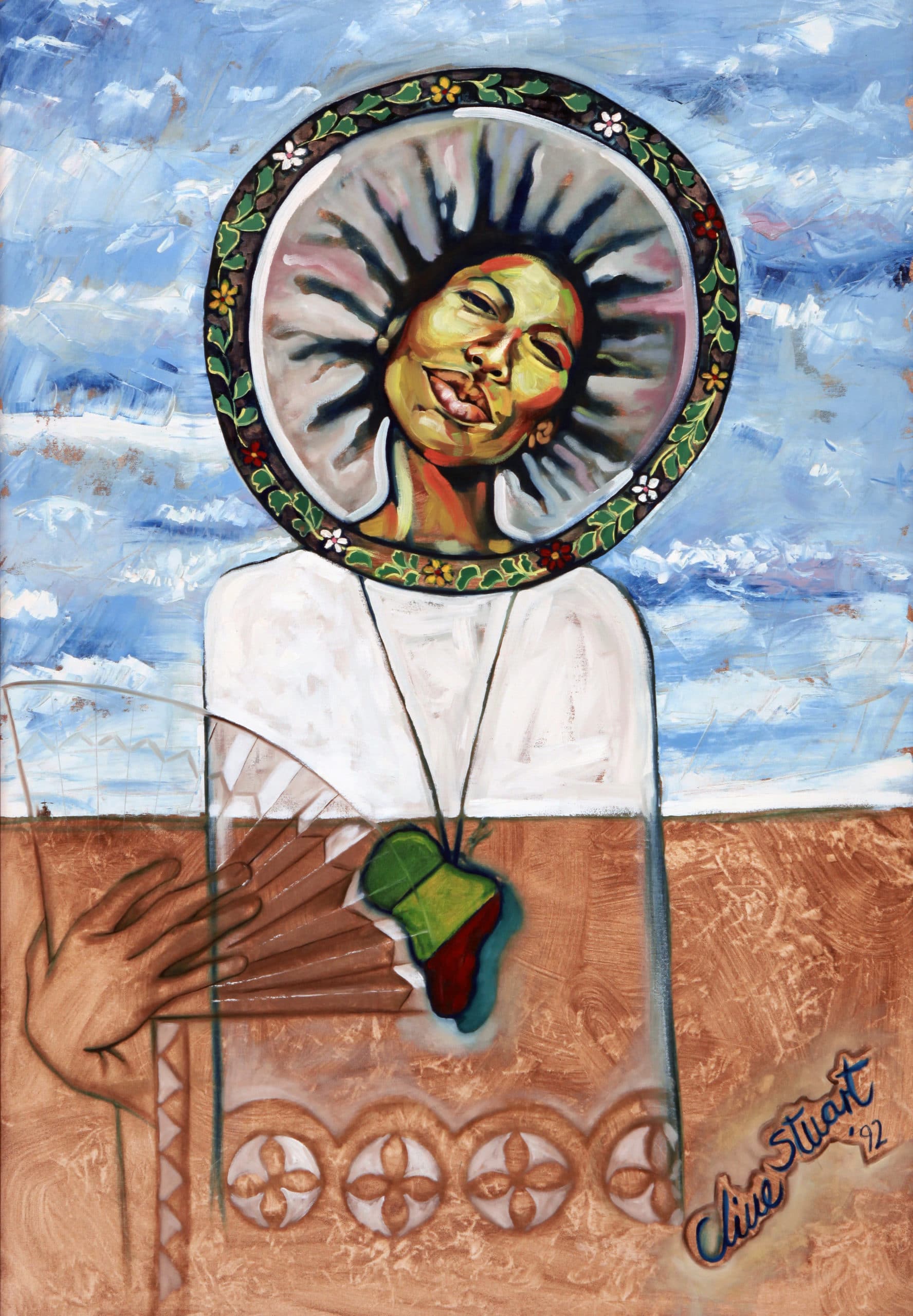
By Natalie Willis.
Clive Stuart’s “Mother Earth” (1992; acrylic on plywood) is a serene and unapologetic celebration of both womanhood and Blackness. Born on Cat Island, Stuart imbues “Mother Earth” with the spirituality, magic, and mysticism of his birthplace. With an unapologetic Black woman standing front and centre as subject, the work celebrates just that – Black womanhood and all that it comes with.
Stuart’s journey parallels that of many other Bahamian artists from his generation. He first began his training in school under the tutelage of Sandra Illingsworth (alongside his contemporaries, John Beadle and Jolyon Smith), is a graduate of both the College of The Bahamas, followed by the popular choice for many of our notable artists – The Rhode Island School of Design. Perhaps his thoroughly Bahamian upbringing, along with his experiences as a foreigner in the US for his tertiary education, led him to want to embrace his Bahamianness in this very diasporic sense of Blackness.
With an interplay of European religious iconography (angelic women with halos) and symbolism of the Black diaspora (the shape of the African continent, a Rasta flag, and natural hair), Stuart actualizes his own deities and queens. Much of Western media portrays Black women as the angry woman, the mystic, the hypersexual desirable being, the struggling saviour, the strong ‘mama’ and a host of lazy stereotypes that lack depth, reducing Blackness to a personality in itself rather than exploring the layers and multiplicity of backgrounds of Black women across the globe. How can an entire race be solidified into a single personality with such a vast array of experiences between us?
Stuart takes the ‘mystic mama’ trope, and with his positioning as a Black man, exalts his subject with a sincerity, understanding, and humanity in his approach. The serenity on her face, her floating, legless body, and exaggerated physique make her not human, but her face draws us back to her humanity – she is transcendent and while her physical body does not make her what she is, her hair and skin become those things that simultaneously deify her. It suggests that she is woman, but she is also queen, she is a spirit of goodness. She becomes an emblem and manifestation of the pride Black women should have in their phenotypically Black traits.
Hair that would ordinarily be deemed ‘picky’ becomes a halo, sticking into points upward to represent the crown it should be seen as. This halo is also surrounded by a band of flowers – a gesture of growth, commemoration, and love. The ‘mother earth’ becomes paradoxically a being transcendent and greater than her physicality, but also firmly rooted within it. She is a queen crowned and the strength implied in this is softened by the femininity of her fan and the gentleness of her face as she looks down at us lovingly – as if from some unseen throne. To young Black girls having to look at this work, given the height of the piece, the work gains a certain physical presence as guardian – and once these girls grow into women, they look at her as equals… As queens.
American US phenomenon, Solange crooned “Don’t touch my hair…. Don’t touch my crown” and Stuart sees and deifies Black hair as it should be. The subject of much social discourse, Black hair has been politicised in public space in a very particular, very problematic way. From the traditional use of hair relaxers to straighten afro hair to a more palatable (ie: more European) form, to the enforcement of head wraps for Black women in the American South, this hair has history. And it also has echoes in our present with students of C. R. Walker – a stone’s throw away from the Gallery – were told that their natural hair (worn in a perfectly ‘picked’ puff) looked unkempt. Those of us with hair deemed ‘good,’ hair that does not need to be chemically straightened because the curl pattern is visible enough to be ‘okay,’ can never understand the fullness of this particular kind of discrimination and colourism, but we can certainly do our part to refuse its perpetuation.
“Mother Earth” is mother but also born to a time when we experienced another wave of the Black diaspora in the West reclaiming its agency. Now, over 20 years later, we see this again with the proliferation of the natural hair movement in the last few years. The internet is saturated with videos of Black women with afro hair teaching other Black women with afro hair how to care for their crowns. The language around Black hair is changing and accessible – you can know your hair type from a series of specific curl patterns (ranging from 2A to 4C with 14 other curl patterns in between), how to moisturize your hair in particular based on your individual needs. All Black hair is not homogenous, it is as varied as the history (or ‘herstory’) of Black women.
In what should be mandatory reading for students everywhere, bell hooks said it best: “If any female feels she need anything beyond herself to legitimate and validate her existence, she is already giving away her power to be self-defining, her agency.” (Feminism Is For Everybody, 2000). Stuart’s Black Gaia doesn’t need his validation, this is why she looks down on him from her exalted place of Black spirituality and royalty, but, importantly, he supports her in her power and recognizes her importance.
